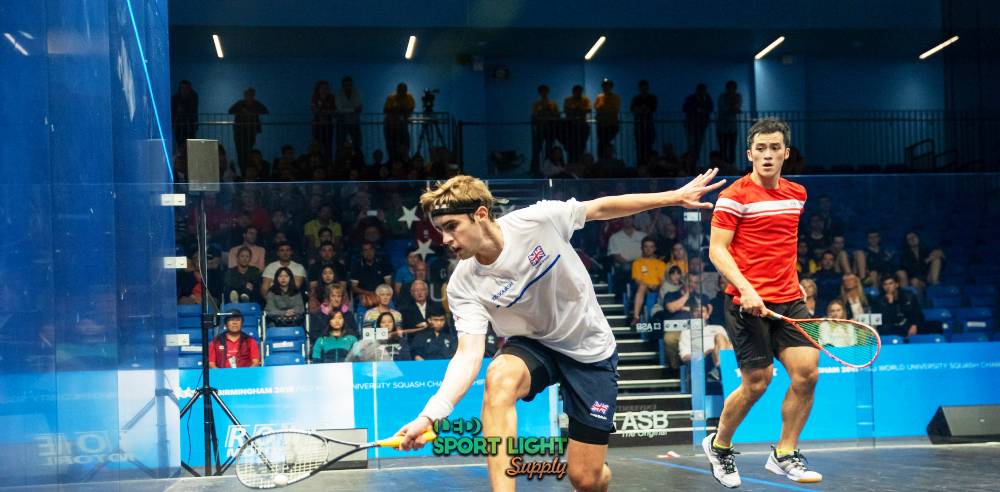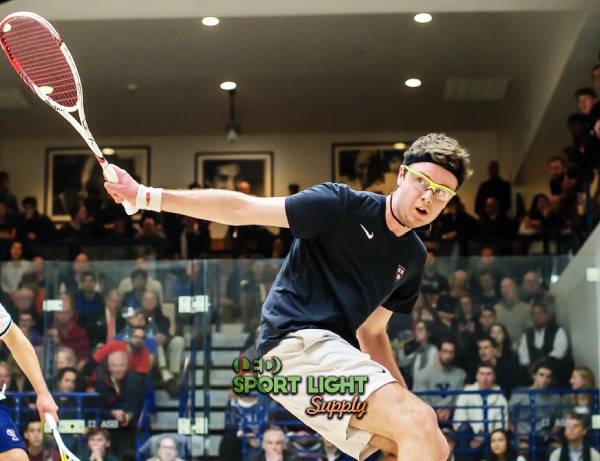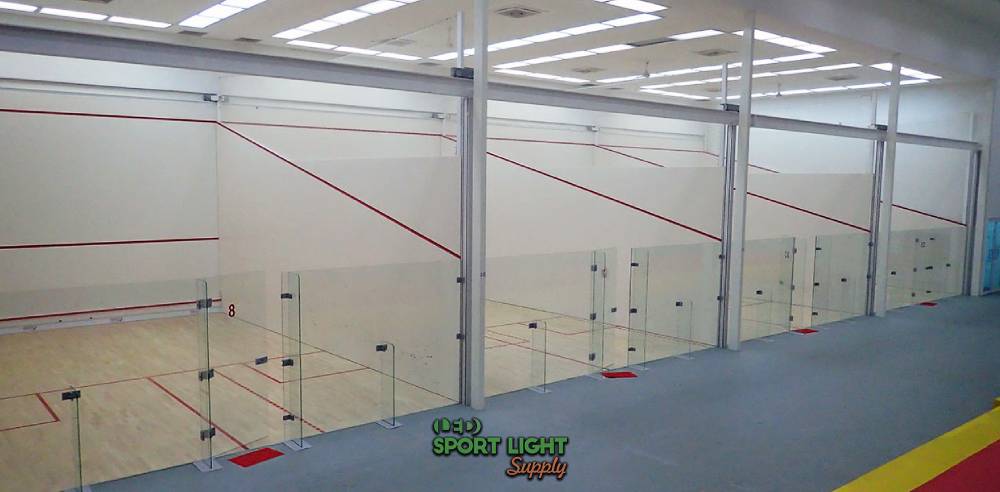Lighting plays a major part in enhancing both the performance of athletes and the overall experience of spectators, especially in high-profile events such as the Olympics. For a sport like squash, where the speed of the ball and precision of movements are crucial, ensuring optimal visibility is a non-negotiable factor. The evolution of lighting technology for sports arenas, and specifically for squash courts, has made it possible to achieve unprecedented levels of clarity, consistency, and atmosphere. Through careful planning and the application of modern lighting systems, Olympic squash courts are equipped with solutions that meet strict standards while offering impressive visual aesthetics.
| Area of the Court | Recommended Lux Level (lux) | Purpose |
|---|---|---|
| Main Playing Area | 750 lux | Provides clear visibility of the fast-moving ball and player movements. |
| Walls and Surrounding Space | 500 – 600 lux | Ensures even lighting across the walls, preventing shadows or dark spots. |
| Audience Section | 300 – 500 lux | Provides sufficient lighting for spectators without causing visual distractions. |
| Court Sidelines | 300 – 500 lux | Ensures proper lighting for the sidelines while maintaining focus on the game. |
Table of Contents
ToggleLux Requirement for Olympic Squash Courts
Understanding Lux Levels for Squash Courts

Lux is the unit of measurement that quantifies the intensity of light that reaches a specific surface, providing a way to gauge the effectiveness of lighting in any environment. For squash courts, especially in an Olympic setting, maintaining precise lux levels is essential for ensuring optimal performance conditions. The visibility of the ball, player movements, and overall playability is directly impacted by the amount of light provided, making it critical to strike the right balance.
In squash, the ball moves at speeds of up to 250 miles per hour, requiring players to have immediate clarity on its path to react effectively. With insufficient lighting, players might not be able to track the ball as accurately, leading to errors or a decline in performance. A light level that is too low can compromise their ability to follow the ball, which may result in a less competitive game. Conversely, excessive lighting can cause glare, which is equally disruptive, affecting not only the players but also the spectators who watch the game.
For an Olympic squash court, the general range of lux required falls between 500 and 1000 lux, depending on the specific needs of the game. However, because the Olympics demand the highest standards, the ideal lux level is often more refined and specific. On average, the main playing area of a squash court targets an illumination level of approximately 750 lux, which provides the necessary brightness for the players to track the ball clearly without causing discomfort due to glare or uneven shadows. This balanced lux level ensures the court remains well-lit and visually accessible, which is crucial for both the players and those watching the game.
Consideration of Different Court Areas
 While the overall lux level for the main playing area is crucial, not all parts of a squash court require the same intensity of light. The lighting design must account for the varying needs of different zones within the court, such as the central playing area, the walls, and the audience sections. Each area of the court contributes to the game experience in its own way, and the lux requirements for each zone should be tailored to ensure the best possible conditions for everyone involved.
While the overall lux level for the main playing area is crucial, not all parts of a squash court require the same intensity of light. The lighting design must account for the varying needs of different zones within the court, such as the central playing area, the walls, and the audience sections. Each area of the court contributes to the game experience in its own way, and the lux requirements for each zone should be tailored to ensure the best possible conditions for everyone involved.
The playing area, where the action takes place, requires the highest lux levels to ensure that the players have adequate visibility of the fast-moving ball and the walls. A typical lux level for this area is around 750 lux. This level provides sufficient brightness while also preventing shadows from forming, which can obstruct the players’ view. The walls surrounding the court, while needing a lower level of lighting compared to the center, should still maintain a balance to reflect light in a way that doesn’t create distracting dark spots or uneven surfaces. These areas generally require lux values between 500 and 600 lux to maintain uniform lighting throughout the space.
On the other hand, areas like the audience section and the court sidelines, while still needing adequate illumination, can afford to have lower lux levels. These zones contribute to the overall atmosphere of the event but don’t require the same intensity of lighting as the playing area. For these parts of the court, lux levels typically range from 300 to 500 lux. This is sufficient to ensure the audience can enjoy the event without being distracted by overly bright or harsh lighting. These levels help create a comfortable viewing environment for spectators while keeping the focus on the court itself.
By carefully considering the lux requirements for each zone of the squash court, organizers can create a balanced and effective lighting environment. The right amount of light ensures that players can perform at their best, while spectators experience a visually pleasing event without the discomfort caused by glare or uneven lighting. Balancing lux levels across the court zones helps achieve this harmony and creates a space where everyone, from athletes to fans, can enjoy the game.
Color Temperature in Squash Court Lighting

Understanding Color Temperature
Color temperature refers to the hue of light emitted by a source, measured in Kelvins (K). The color temperature of a light source greatly affects how the environment looks and feels. For sporting events like squash, the color temperature needs to be carefully selected to enhance visibility, minimize distractions, and contribute to the overall atmosphere of the game. The goal is to have a lighting system that mimics natural daylight as much as possible, providing clarity without overwhelming the players or audience.
Ideal Color Temperature for Squash Courts
For squash courts in the Olympic Games, an ideal color temperature typically falls within the range of 4000K to 5000K. This range is considered “neutral white,” closely resembling natural daylight. A color temperature of around 4500K is often chosen because it strikes a balance between clarity and warmth, creating a clean, sharp appearance on the court. This temperature range helps ensure that both players and spectators experience accurate color reproduction, which is particularly important for a fast-paced game where details such as the movement of the ball and the players’ positions need to be immediately discernible.
Lighting that is too warm (with a lower color temperature) could create a yellowish tint, making it more difficult to track the ball. In contrast, a cooler light (with a higher color temperature) might lead to excessive harshness, causing glare or eye strain. By using a neutral white color temperature, Olympic squash courts can ensure that the lighting promotes the best visual experience for everyone involved.
The Importance of Glare Control
Reducing Glare for Optimal Play
Glare can be a significant issue when lighting systems are improperly designed. In the context of Olympic squash courts, glare can negatively affect players’ focus and cause discomfort for the audience. Proper glare control is a major factor in achieving high-quality lighting. It ensures that the intensity of the light does not create visible reflections or cause discomfort for the athletes as they make quick movements across the court. By focusing on the strategic placement of light sources, glare can be minimized, providing an evenly lit environment where the focus remains on the action on the court.
To reduce glare, modern squash court lighting systems often employ technologies like anti-glare lenses or diffusers. These mechanisms help distribute light more evenly across the court without concentrating it into bright, concentrated spots. In Olympic squash courts, this becomes even more important because the games are held under highly professional conditions and watched by a global audience. Spectators, both in the venue and watching from their homes, need to see the action clearly without distractions caused by harsh lighting.
Proper Fixture Positioning
The positioning of lighting fixtures on Olympic squash courts is another critical factor in reducing glare. Overhead lighting is typically arranged in such a way that no light sources are directly visible to the players or the audience. Fixtures are usually placed above the court, at specific angles, and in precise arrangements to create an even distribution of light without generating direct glare. Additionally, the fixtures’ beam angles and wattage are selected to ensure that the court’s lighting is not only effective but also comfortable for everyone involved.
Types of Lighting Systems
LED Lighting for Squash Courts
Among the many lighting options available for Olympic sports venues, LED technology stands out as the most effective and sustainable choice for squash courts. LEDs are energy-efficient, durable, and capable of delivering high-quality light output with minimal maintenance requirements. Unlike traditional incandescent or fluorescent lighting, LED lights are designed to provide an even, high-intensity light source, ideal for illuminating squash courts with precision and clarity.
LED lights also offer greater control over brightness and color temperature. With advanced dimming features, they allow for fine-tuning of light intensity, ensuring that the lux levels are consistently met without over-illumination. Additionally, LEDs are more environmentally friendly, consuming less energy than other lighting types and lasting much longer, which reduces the need for frequent replacements. In the context of an Olympic squash court, this makes them an excellent choice for both performance and sustainability.
Tunable White LED Systems
Tunable white LEDs allow for a customizable color temperature range, which can be adjusted to match specific requirements. This system can be particularly advantageous in an Olympic setting where different lighting conditions may be needed at various points throughout the day. The ability to adjust the color temperature ensures that the courts maintain optimal visibility and ambiance throughout the event. It also provides flexibility for different camera and broadcast requirements, allowing for the lighting to be tailored for specific television production needs.
Lighting Systems for Broadcast and Camera Quality
Achieving Ideal Lighting for TV Broadcasts
Squash is a fast-paced sport that requires precise camera work to capture every moment. For Olympic squash courts, lighting is not only crucial for the players but also for creating optimal conditions for broadcast coverage. The lighting system must be designed to prevent shadows and flicker, ensuring that every movement on the court is captured with clarity. Modern lighting technology can address these issues by providing stable, flicker-free lighting that ensures smooth video quality, even in high-speed motion.
A high CRI (Color Rendering Index) value is also important in this context. The CRI is a measure of how accurately light displays the colors of objects under its illumination, compared to natural light. A high CRI value (typically above 90) ensures that players, their uniforms, and the ball are portrayed in their true colors, which is essential for both in-person spectators and viewers watching on television. For Olympic squash events, this level of detail and accuracy is important to provide a high-quality viewing experience for the audience worldwide.
Lighting Consistency Across Broadcasts
During international events like the Olympics, broadcasting standards require consistency in lighting across various venues and broadcasts. The lighting system must maintain uniform intensity and color temperature across different squash courts to ensure that there is no disruption to the viewer’s experience. Broadcast lighting must be able to accommodate various camera angles, and the lighting design needs to work harmoniously with both the sport and the technology used to capture it. By utilizing cutting-edge LED technology and tunable white lighting, Olympic squash courts can ensure that the lighting system supports both players and camera operators with consistency and precision.
Sustainability in Lighting
Eco-friendly Lighting Practices
Sustainability is an increasingly important aspect of modern lighting design, particularly in global events like the Olympics. With energy consumption and environmental impact being key considerations, Olympic squash courts benefit from the application of energy-efficient lighting systems. LEDs, in particular, are known for their low energy consumption and long lifespan, which significantly reduces the carbon footprint of the event.
Beyond just energy efficiency, sustainability in lighting design also involves using recyclable materials and minimizing waste. Advanced LED systems often come with minimal maintenance needs, contributing to lower resource consumption throughout the event’s duration. The long-lasting nature of these lighting solutions also ensures that the investment in lighting infrastructure benefits future sporting events.
Reducing Light Pollution
A well-designed lighting system can also minimize light pollution, which is the undesirable effect of excessive artificial light spilling into the surrounding environment. By employing focused lighting and shielding techniques, Olympic squash courts can direct light only where it is needed, reducing glare and light trespass that could affect the surrounding area. This not only creates a more pleasant environment for athletes and spectators but also aligns with global sustainability efforts by conserving energy and reducing the impact of artificial lighting on the night sky.
Lighting Design for Enhanced Atmosphere
Creating the Right Ambience
While functional considerations like lux levels and glare control are paramount, lighting can also play an aesthetic role in shaping the atmosphere of the Olympic squash courts. By carefully selecting the lighting layout and design, organizers can create an engaging and visually appealing environment that adds to the excitement of the game. Through the use of subtle accent lighting and the intelligent placement of light fixtures, the court can be transformed into an inspiring setting that enhances the Olympic experience for players, spectators, and viewers alike.
Athletes benefit from a lighting environment that is not only functional but also psychologically stimulating. The right lighting can help energize players, providing them with a sense of focus and intensity that boosts their performance. Meanwhile, spectators enjoy an immersive experience, where the lighting serves to amplify the thrill of the game, making the Olympic squash courts feel dynamic and alive.
By focusing on the integration of cutting-edge lighting technologies with practical design considerations, Olympic squash courts can achieve a perfect balance between performance, aesthetics, and sustainability, contributing to the legacy of the Games for years to come.
Conclusion
For squash, a sport requiring precise vision and rapid reactions, lighting not only affects performance but also the overall atmosphere of the venue. By utilizing advanced technologies such as LED systems with tunable color temperatures, squash courts can achieve optimal lux levels, minimize glare, and create a visually compelling environment. These innovations not only ensure the players can perform at their best but also provide an enhanced viewing experience for audiences both in the stadium and at home.
The strategic placement of lighting fixtures, alongside careful consideration of color temperature and energy efficiency, ensures that the squash courts at the Olympic Games remain among the best in the world. As sustainability becomes more important, the adoption of eco-friendly lighting solutions further contributes to the reduction of the environmental impact of large-scale sporting events.
Through these cutting-edge lighting solutions, the Olympic squash courts not only meet the demands of a high-performance sporting environment but also deliver an exciting, visually cohesive experience that celebrates the spirit of the Games. Whether it’s the clarity provided to players or the ambiance enjoyed by fans, lighting plays a critical part in making Olympic squash a memorable spectacle.
